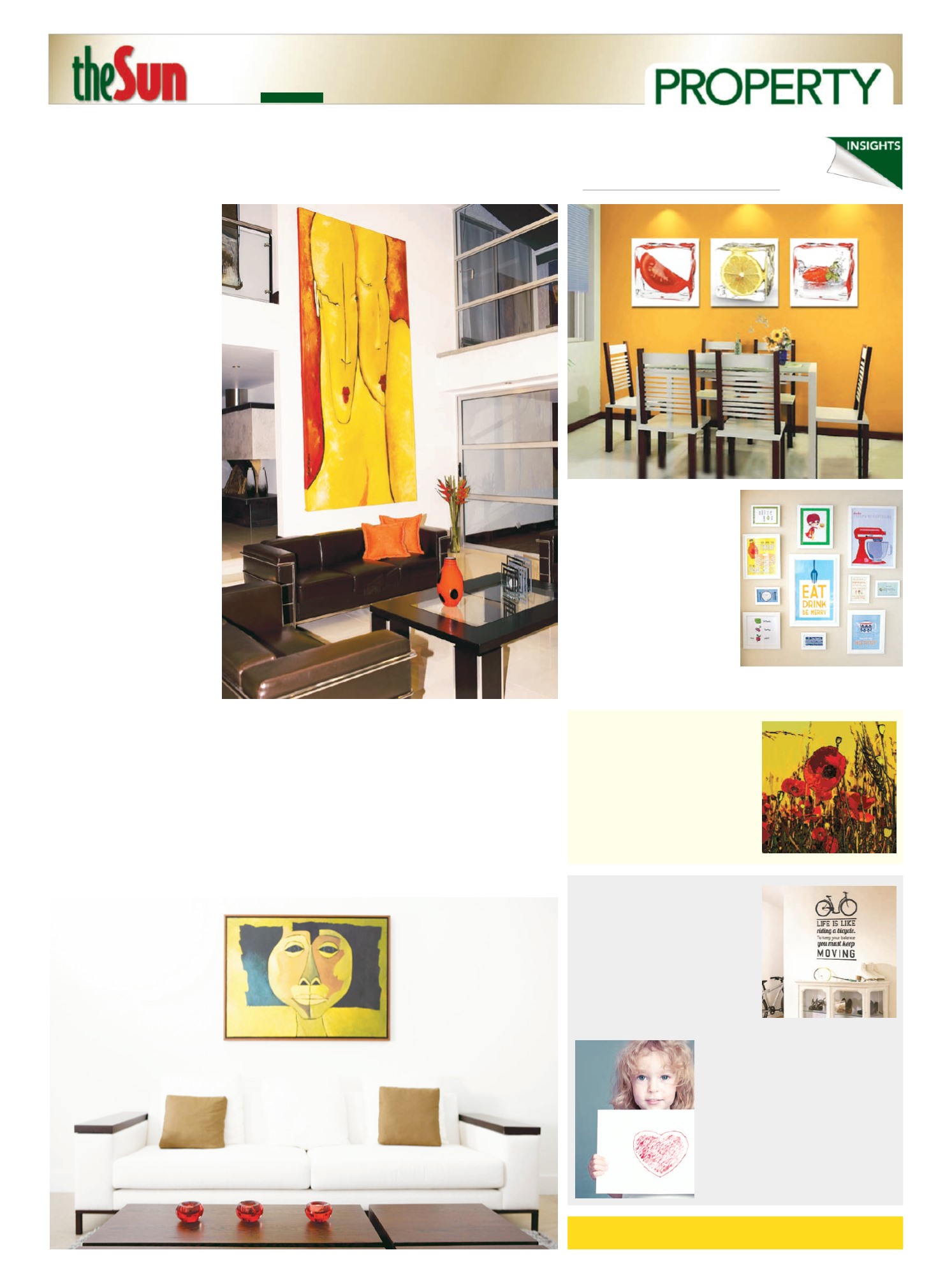

ON FRIDAY
JULY 3, 2015
Email your feedback and queries to: propertyqs@
thesundaily.comX
W
HEN
it comes to
boosting the character
and flamboyance of a
room, nothing does it
better than art. “Regardless of a
person’s knowledge, budget or taste
in art, anyone can decorate their
home with it,” says interior designer
Gerard Chen.
In fact, showcasing artwork can
turn dreary and dull walls into
somethingmore vibrant and
outstanding. Art pieces can also act
as conversation pieces. They can
also be established according to a
theme in one’s interior decor.
However, to get themost out of an
artistic display, certain guidelines
need to be followed. “And these
belowwill ensure your artwork
balances and enhances a room
instead of overpowering it,” says
Chen.
SIZEMATTERS
A key element when decorating
with art is the size of the piece in
relation to the rest of the room. The
position of the art is also important
andmust also be coherent with
the scale of the room, otherwise it
might either take toomuch
attention away or become obscured
by other objects.
“A collection of artwork always
requires amainstay or anchor close
to it (usually a couch, console table
or headboard in the bedroom), and
this selected itemwill dictate the
scale of the art display. As a rule of
thumb, the artwork should not be
the same size as the anchor. A better
choice would be to put up a painting
which is roughly 2/3 the width of the
anchor. Position the piece so that its
centre is roughly 50 inches from the
floor with the lowest point roughly
10 inches higher than the anchor’s
back,” advises Chen.
SPACE IT RIGHT
Overcrowding can spoil the positive
effects that artwork and paintings
have on one’s home. There is a
minimumamount of space required
between artistic pieces, in order for
them to remain independent and in
context. “If the (collection of)
artwork is related, at least two
inches should be visible between
frames. This is so that the display
looks like a specific, cohesive
collection instead of randomchaos,”
Chen reveals.
If the (collection of) artwork is
not related by subject, then the
various pieces should be kept apart.
“If a homeowner has 10 pieces of
>Displaying, exhibiting and
showcasing art in interiors
Artistic
touch
completely unrelated art hung up,
then the roomwould lose its focal
point and the art becomes an
obscured background, instead of
points of interest,” Chen reasons.
THEMED TO PERFECTION
Identifying the style or theme of a
room is helpful in deciding what
type of art it should have. “An
example of this would be a beach
theme in the children’s room. All art
pieces should somehowbe related
to this theme,” he adds.
Thematerials used and colour
patterns of the artwork, and how
they relate to the room’s other
features (i.e. the lighting, fan,
accessories), should also be taken
into considerationwhen choosing
pieces to display. Styles should
blend in naturallywith the other
elements of the room in question.
Fromwallpaper to the purpose of
the area or room itself, your chosen
art piece to display should have
some formof connection. Let us use
the kitchen in this case. You could
style the area using light curtains,
upholsterywith small motifs or
wallpaper with light designs, all
with hints related to the kitchen
or F&B. Thenmake a statement by
hanging up amore ostentatious
painting, also pertinent to cookery
and comestibles.
MAKE A STATEMENT
Sometimes, one can theme and
match the entire area or whole
interiors inmuted tones and break
themonotony by displaying a
“talking piece”. Art pieces of this
nature usually stand out in terms of
size, shape, colour or texture, and
its characteristics are different,
rather unusual fromwhatever else
is in the surrounding.
A good example is a house in
black andwhite, which has a huge,
unusually shaped sofa thrown right
smack in themiddle of the living
room… and in shocking pink!
DIFFERENT ARTWORKS FOR
DIFFERENT THEMES
Stumped on what artwork to use for
different rooms? Here are some
examples:
Floral, botanical, food or fruit inspired
art for country-styled rooms (bedroom,
dining, kitchen)
Black and white art for eclectic rooms
(living room, bathroom)
Landscape art for contemporary rooms
(living, dining, home office)
X
X
X
ART SAVVY
Art does not have to be expensive.
Here are five ways to acquire art
without burning a hole in one’s pocket.
Recycle calendars
: The best part is,
calendars are usually themed.
Make use of travel mementos
:
Decorate with those sea shells from
your trip to the beach by framing it up
or even use artifacts from yesteryear
like a violin or an old guitar.
Children’s art
: Who says four-year-
old doodles and pieces of art only
belong on the fridge? Pair it with some
fancy frames and display it for everyone.
Browse through your collections
:
Got a wide stamp collection? How about
an assortment of caps or matchboxes and
such - these make great and interesting
pieces of art.
Wall décor quotes
: Did you know that
you can turn your favourite inspirational
messages and quotes into pieces of art?
Try it! These act as calm-me-downs and
pick-me-ups, apart from being
aesthetically pleasing to the eye.
There is art in everything around us …
all you need to do is be creative!
X
X
X
X
X
PHOTO: ADDSARTICLES_COM
PHOTO:
BLOG.FINSAHOME.CO.UKPHOTO:
COOLWALLART.COM


















